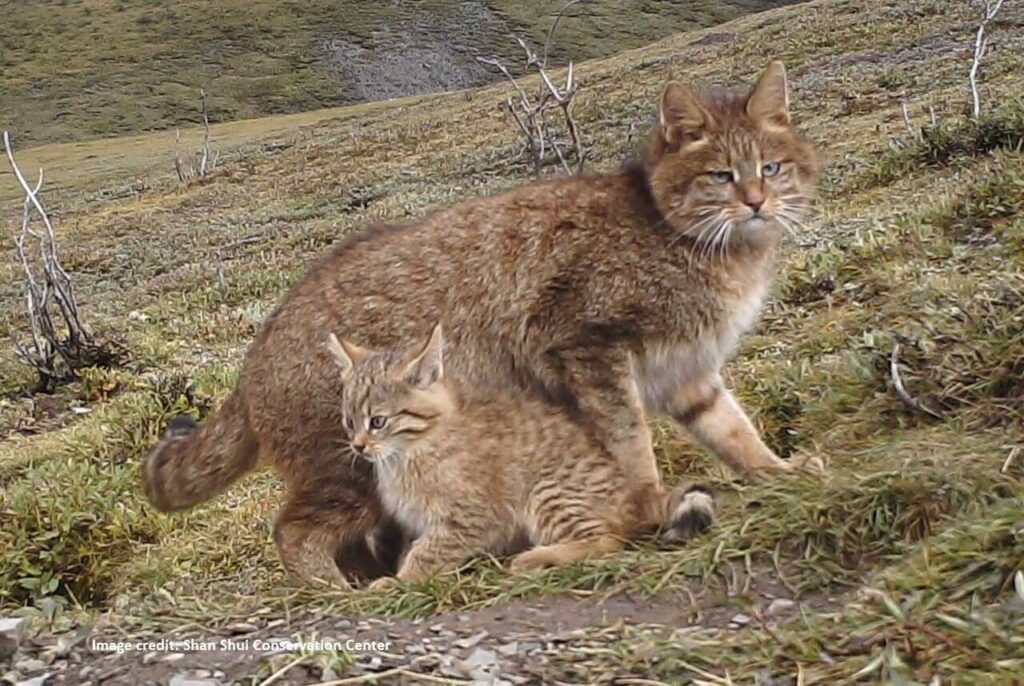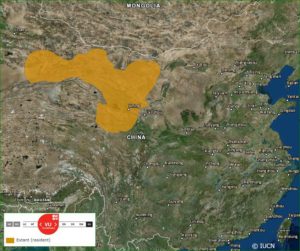

- Head Body Length: 68.5-84 cm (27-33″)
- Tail Length: 32-35 cm (12.5-14″)
- Weight: one wild caught male weighed 9 kg (19.8 lbs), one female 6.5 kg (14 lbs)
The Chinese Mountain cat Felis bieti is found only in China, and the first photo of this cat in the wild came from a camera trap in 2007 at 3,700 m. They are thought to be restricted to the eastern edge of the Tibetan plateau, and are found primarily in alpine meadow habitats from 2,500 to 5,000 m.
Distribution

The only confirmed locations for this small cat are in the provinces of Quighai and Sichuan. This limited range means the cat has adapted to the harsh climatic extremes that occur seasonally and with altitude; open, dry, windy and very hot as well as very cold. It inhabits steppe grasslands at high elevations, alpine meadows and alpine shrubland. It has not been found in true desert or dense forest.
Ecology
Resembling a stocky domestic cat with relatively short legs, Chinese Mountain cats have a uniform colouration, generally lacking any dark markings on their flanks. The coat is pale yellowish-grey in winter, darker and marked with brown flecks in summer. Faint horizontal brown lines run across the sides, legs and cheeks. Underparts are white and the throat appears pale yellowish-brown. Their ears have short, dark tufts and are yellow-grey on the backs. The last part of the tail has 5-6 dark grey bands and a black tip. The fur on the soles of the feet is long and protrudes between the pads.
No ecological studies have been conducted in the wild, but much knowledge comes from local herders and from work done in the Xining Zoo. Local people call it the Grass Cat, as the fur matches dry grass stalks so exactly: grey closest to the skin, turning brown ending in blond tips.
Interviews with local people and zoo observations indicate this cat is primarily nocturnal and crepuscular. They rest in burrows during the day which have been found on south-facing slopes,some as high as 3,600 m. They are solitary, and little is known of their reproductive activity in the wild.
In their mountainous habitat this cat hunts mainly rodents, rabbits and birds. The importance of pikas as a major prey species ties the fate of this cat to human interactions: when local irruptions of voles and pikas lead governments to supply poison for pest control, the cat no doubt suffers the consequences. No longer widespread, the practice still occurs on a smaller scale. Recent work has shown that rodent outbreaks result from overgrazing and by addressing this problem, poison use could be eliminated.
Conservation
Population status and trends are unknown. Serious threats continue from the results of rodent poisoning programs and from hunting for fur.
Local people hunt the cats to make accessories such as small seating furs, waist bands and warm hats from winter skins when the fur is thick and rich. They also sell prepared skins to local traders for the tourist market in China. The cats are easily caught in winter when tracks in the snow can be followed to den entrances, where poisoned meat is placed. The next day, they follow the snow tracks to the body.
The Chinese Mountain cat is not protected over most of its range. Effort is needed to monitor its status and secure conservation measures for this unique species. One conservation group in China is currently planning a monitoring and survey program for this species.
Long considered a subspecies of the Wildcat Felis silvestris, current taxonomy for this cat is uncertain. It is currently classed as a separate species but the status is under review by the IUCN/SSC Cat Specialist Group.
Updated 2017
![]() In 2018, researchers working on a Black-necked crane project made a very exciting discovery. They filmed a female Chinese Mountain Cat and two kittens near a den, and the resulting footage is spectacular. See Chinese Mountain Cat – Birding Beijing for the full article and video.
In 2018, researchers working on a Black-necked crane project made a very exciting discovery. They filmed a female Chinese Mountain Cat and two kittens near a den, and the resulting footage is spectacular. See Chinese Mountain Cat – Birding Beijing for the full article and video.